Employers continue to face compliance challenges in determining whether a new hire is work authorized for Form I-9 purposes, given the dynamic changes in immigration policy and regulation. For instance, this year alone, U.S. Citizenship and Immigration Services (USCIS) has posted significant updates on the Form I-9 Central news page, including:
- The increase of the maximum validity of certain Employment Authorization Documents (EADs) to five years.
- The requirement to use the new Form I-9 (08/01/2023) as of November 1, 2023.
- The use of the Alternative Remote Procedure for Examining Form I-9 support documents for qualifying E-Verify employers.
- The end of the COVID-19 Form I-9 flexibilities.
- The extension of certain I-751 and I-829 legal permanent resident cards' (LPRCs) validity to 48 months.
- The extension and/or redesignation of multiple Temporary Protected Status (TPS) nationalities' work eligibility.
These changes are not updated timely in the basic Handbook for Employers (M-274) as to Form I-9 compliance. Consequently, employers are expected to mine for compliance information across a variety of platforms, including Form I-9 Central, Federal Register notices of regulatory changes, policy memoranda, I-9 Central postings, the Department of Justice's Immigrant and Employee Rights (IER) website, the E-Verify website, etc. to figure out their current compliance standards/requirements. It is crucial to remember that an acceptable List C document, which is a document that verifies work eligibility only, contains the "Joker's Wild" option (#7) of a "document authorized by the Department of Homeland Security (DHS)." While the Form I-9 includes links to specific examples of acceptable DHS employment authorization documents, there is no complete list of these documents available. In addition, employers need a fundamental understanding of the basic nonimmigrant visa categories, allowing an employee to be work authorized for Form I-9 completion to avoid some basic errors.
TNs and Work Authorization
TN visas are available to an identified list of professions that specify requirements for the occupation, which are referenced at 8 CFR §214.6 and at 9 FAM 402.17. The TN visa category is based on the North American Free Trade Agreement (NAFTA), which was replaced by the U.S. Mexico Canada Free Trade Agreement (USMCA) in July of 2020. The list of TN professional occupational occupations was retained under the USMCA. Dependents of TN visa holders, TD spouses and children, are not work authorized but may live and study in the U.S.
TN visas or admission to the U.S. in TN status (e.g. visa exempt Canadians) basically requires the following:
- Be a citizen of Mexico or Canada.
- Be requesting admission to perform a listed TN professional occupation.
- Qualify for the TN professional occupation.
- Have pre-arranged qualifying employment, if approved, on a full-time or part-time basis (not self-employment).
While most of the TN occupations do not require a specific degree, it is important to remember that the federal agencies assessing whether admission or a visa may be granted in TN status review if a degree in a related or allied field to the profession is appropriate. There is no annual cap on the number of nonimmigrants, who may be granted admission in TN status or a TN visa. In addition, there is no mandate that the prevailing wage or higher be paid for the area of intended employment. The TN professional categories are not a legal conduit for lesser skilled manual labor.
Trade Nafta (TN) Trafficking and Nonimmigrant Fraud
In times of high employment in the U.S. with many job openings, the impetus for employers to comply with laws often can be subverted by the need to keep the doors of the business open. For example, Bloomberg Law News reported in October of 2023 that auto parts suppliers to two prominent automotive manufacturers in Alabama and Georgia are subjects of a new lawsuit due to allegations of a labor trafficking scheme using the TN visa category. The defendants in the case include the parts manufacturer, a staffing firm, and a recruiter, who allegedly recruited Mexican engineers and technicians for nonexistent TN jobs and then placed them in low-paid, manual labor jobs upon arrival in the U.S. In addition, some of the TN workers were allegedly threatened with deportation, if they complained about their allegedly fraudulent employment and pay.
The occurrence of misrepresentations in visa applications or admission requests is a familiar concern for both U.S. consular posts abroad and U.S. Customs and Border Protection (CBP) officers at the ports of entry. A prime example is the B-1 business visitor category, which is frequently pushed to its limit to facilitate entries to the U.S. for impermissible purposes, such as work that displaces a U.S. worker. The $34 million fine paid by Infosys Limited is an example of this B-1 fraud in relation to open labor positions in the U.S. The holders of B-1 business visitor visas and B-2 tourist visas are not permitted to work in the U.S. The term "work," however, is not always straightforward to interpret. Unfortunately, U.S. employers may inadvertently make well-intentioned errors in determining whether a nonimmigrant visa holder is work authorized.
A determination of material fraud in an application for admission to the U.S. or for a visa at a U.S. consular post can lead to a permanent bar to admission to the U.S. under section 212(a)(6)(C)(i) of the Immigration and Nationality Act, as amended (INA). At a port of entry, a CBP officer can subject applicants for admission to expedited removal for willful misrepresentations of material facts. At a port of entry and a consular post, there is no right to legal representation at the time of the application for a nonimmigrant visa or admission to the U.S. Thus, trying to prove what actually happened is very challenging after the fact. In addition, employers, recruiters, or staffing agencies sponsoring such applicants can be subject to subsequent investigation for facilitating fraud, which can result in criminal liability. The October 2023 lawsuit noted above also accuses the defendants of violating the forced labor and trafficking for forced labor provisions of the Trafficking Victims Protection Act (TVPA).1
The Work Authorized Nonimmigrant
Normally, an employer-sponsored nonimmigrant (e.g. TN, H-1B, H-1B1, E-1, E-2, E-3, L-1, O-1, etc.) will choose to present a foreign passport for identity and an associated I-94 admission record to prove work authorization under List A of the Form I-9. The sponsoring employer is well aware that the employee will probably be presenting an I-94 record of admission in the sponsored nonimmigrant category or the I-797A approval notice for a change or extension of status with the I-94 record at the bottom of the approval notice along with their passport biographic page to complete List A of the Form I-9.
This List A method to confirm work authorization and identity using the Form I-9 can be very challenging to employers since CBP transitioned to the online I-94 admission record and there is no designation of the sponsoring employer's name on the I-94. https://i94.cbp.dhs.gov/I94/#/home A downstream employer that is not knowledgeable as to nonimmigrant categories could end up accepting, for example, qualifying documents for List A, which convey no work authorization.2
How does this happen? Please refer to List A, #5 from Section 2 of the Form I-9, excerpted below:
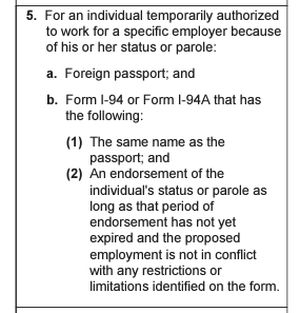
If a Mexican or Canadian TN nonimmigrant engineer is admitted to the U.S., they will have their passport with its biographic page to prove their identity, if they choose to present it, for List A compliance with Form I-9. Note that they may of course choose to present a qualifying List B document for proof identity, if they have one, in combination with a List C document, if they have one.
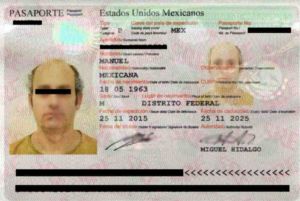
As to proof work authorization though, option #5 noted in List A of the Form I-9 only requires a Form I-94 or I-94A specifying the name of the visa holder on the passport and an "endorsement" that "has not yet expired and the employment is not in conflict with any restrictions or limitation on the form."
What does that mean in the context of an I-94 issued by CBP or the I-94 at the bottom of a USCIS I-797 approval notice?
CBP – Note that the I-94 CBP record on line or via a paper I-94 (below), which is rarely issued anymore at ports of entry, does not include the name of the authorized employer. The category of admission is noted (e.g. B-1, TN, etc.). In this situation, the employer should know that unless the TN admission was based on sponsoring documents prepared by the employer, that the TN visa holder's I-94 would be "in conflict" with employer sponsoring restrictions. The TN visa or status holder must be admitted or approved to work for the sponsoring employer.
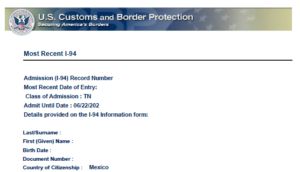
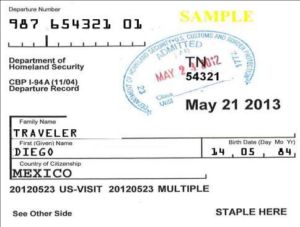
USCIS – In contrast, the I-94 record at the bottom of the I-797 approval notice issued by USCIS does indicate the petitioner name at the top of the I-797 approval notice as well as in the I-94 section of the approval notice. In addition, the I-94 information based on the I-797 approval by USCIS is not replicated in the CBP I-94 online records, which causes confusion for those trying to retrieve their current I-94 record online.
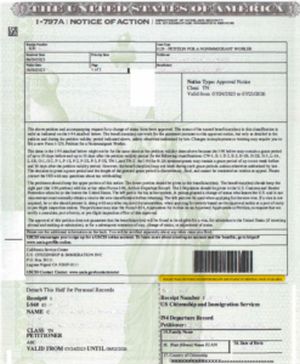
Thus, when relying on the CBP I-94 record online, it is far easier for employers to think, in error, that the TN admission or for that matter other nonimmigrant categories of admission (e.g. O-1, H-1B, H-1B1, E-3, etc.) provide a carte blanche authority for the nonimmigrant to work in the U.S.
Authorization for New Employer or Additional Employer
Another challenge confronts employers who may be unaware that, in order for a nonimmigrant to be permitted to work for a new employer, the nonimmigrant must either be approved for a new visa (if applicable), authorized to work for the new employer through an amendment approved by USCIS, or authorized to work for a new employer through readmission to the U.S. based on a new employer's supporting application at the port of entry (when applicable). There are a variety of permutations to consider. Some examples are as follows:
- The Canadian TN status holder who may apply for readmission at the northern or southern border port of entry based on a new sponsoring employer's documentation. They may also apply for authorization from USCIS via a new I-129 petition.
- The Mexican TN visa holder may apply for a new visa or a USCIS approval to change employers while maintaining TN status. 8 CFR §214.6(i)(2). Note that there has been conflicting guidance provided by CBP as to the ability of a Mexican TN nonimmigrant to change employers during the validity period of their I-94 admission record by going to the port of entry to present a new employer's sponsoring documents. One of the more recent interpretations by CBP recognizes that the Mexican TN does not have the same simpler method as a Canadian TN nonimmigrant to change employers at the port of entry. This issue is subject to ongoing review by CBP. It is extremely important that this point be resolved since the consequences of unauthorized work for the employer and employee are serious.
Work Authorized Nonimmigrants as Not Free Agents
The common premise to remember is that a TN nonimmigrant (as well as most other nonimmigrant work authorizing categories) cannot just move as a free agent among employers post admission or visa issuance. Due to the Form I-9 List A requirements of only an I-94 and passport biographic page for List A compliance, employers are often considering a nonimmigrant as work authorized when that authorization is employer-specific. Employers also have to be concerned about not requesting additional documents to prove work authorization to avoid exposure to citizenship or national origin discrimination. IER outlines numerous examples of document discrimination on its website.
CBP should expedite the update of its online I-94 system to specify the employing sponsor as well as to include the most recent I-94, whether issued by USCIS or CBP. In addition, USCIS should amend the Form I-9 List A requirements to include clear instructions to review the sponsoring employer on the visa foil in the employee's passport and/or I-797 approval notices to end this confusion, which exposes employers to Form I-9 related sanctions/penalties.
Footnotes
1. See 18 USC §§1589 and 1590.
2. See Handbook for Employers, M-274 https://www.uscis.gov/book/export/html/59502 .
The content of this article is intended to provide a general guide to the subject matter. Specialist advice should be sought about your specific circumstances.
